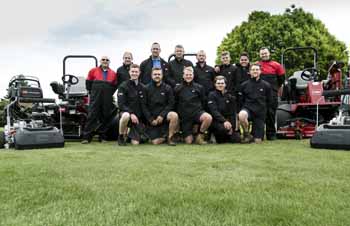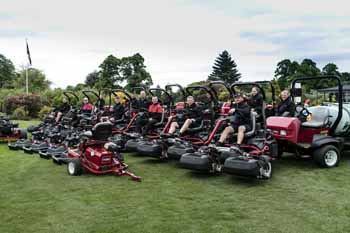Greenkeeping team profile: Royal Mid-Surrey Golf Club
Gavin Kinsella and Doug Tate are the courses manager and course head greenkeeper at Royal Mid-Surrey GC respectively. They talk about the contrasting work between summer and winter, dealing with a course next to a river and why they love their jobs so much
Situated just 20 minutes outside central London in Richmond, Royal Mid-Surrey Golf Club is set in the tranquil surroundings of Old Deer Park next to the Royal Botanical Gardens at Kew. The club celebrated its 125th anniversary last year and boasts two 18-hole championship courses – both designed by five-time Open champion JH Taylor, the club’s first professional.
The Golf Business caught up with courses manager Gavin Kinsella and his deputy Doug Tate, to find out more about the work that goes into maintaining courses at such a prestigious golf club.

Tell us a little about your background and how long you’ve worked at Royal Mid-Surrey.
Gavin Kinsella: I celebrated my tenth anniversary here in July last year. After attaining my qualifications, I spent two years in America, first at Ohio State University then at Penn State University. I interned at a couple of courses over there before I got a job with the European Tour preparing courses for tournaments. Before coming here, I spent six years at Royal Blackheath Golf Club.
Doug Tate: I’ve been at Royal Mid-Surrey for almost two decades, having started as a 17-year-old trainee greenkeeper. I have been the courses’ head greenkeeper since January 2013 and I am qualified with an NVQ Level 4 from Merrist Wood College.
The club celebrated its 125th anniversary last year and hosted a number of prestigious tournaments. How challenging was it maintaining two courses throughout?
Gavin Kinsella: It was a huge challenge for the team, but one we relished. It’s great to work alongside 15 other members in the greenkeeping team who take so much pride in their work. The whole team embraced the challenge from day one. Sometimes getting access to the course was tricky, so we approached the club and asked them to shut the course for a few hours so we could carry out essential maintenance. Nine times out of ten they agreed.
Also, the club committee approved a significant order for Toro fairway and green mower machinery plus several utility vehicles which made our job much easier. In all, we operate about 24 pieces of kit, including six ride-on triple machines.
Doug Tate: Quite rightly, our members have high expectations and it’s our job to ensure that both courses are in the best possible condition throughout the year. It doesn’t matter if one course is the best in the world – as a greenkeeper you’re not doing your job properly if you neglect the other course. As well as the new equipment, we use various tractor units, turf rollers and hand tools designed for an array of horticulture and turfcare work to maintain the best standards.

What’s the best part of your job?
Gavin Kinsella: To be part of such a forward-thinking club like Royal Mid-Surrey is a a big benefit. We enjoy working at such a thriving club with a great working environment. It’s always nice to hear members and guests compliment you on the condition of the courses. I love the variety and new challenges that each day presents.
Doug Tate: No day is ever the same and you learn something new each day working alongside so many talented people. It feels like being part of a family in many ways because we all get along so well. I certainly see more of the guys here than I do my own family!

How much of a challenge does the winter period present when maintaining the two top-class courses?
Gavin Kinsella: Frost is the big enemy in the winter. The damage caused by frost can vary considerably and is influenced by a number of different factors. These include the weather conditions preceding the frost; soil type and drainage; the types of grass; and the amount of play the course has been subjected to. We never like having to close the courses, but sometimes we’re left with no option. You’ve always got to think about the long term in this job.
Doug Tate: Heavy rain can also prove a problem during the winter when the ground could be saturated. Ironically, I find the summer is the hardest time of year, because that’s when expectations are at their highest. Golfers understand that no course will look its best in mid-January, but there’s no excuse over the summer months!

The bunkers at Royal Mid-Surrey are known to be in top class condition. How do you maintain them?
Gavin Kinsella: Bunker maintenance is divided into two areas – everything inside and outside. Inside the bunkers we work on tasks like strimming, blowing and hand weeding the faces to maintain a proper shape and depth of sand. Outside we focus on mowing, topdressing, overseeding, fertiliser application, hand watering and weed control on the top of the bunkers.
Doug Tate: The choice of sand is also crucial. We use Wareham sand and redistribute it evenly across the bunkers and up the faces as required. Each bunker – a total of 135 in all – receives a full raking every day. Since 2009, all 63 bunkers on the JH Taylor course have been rebuilt entirely and some of the 72 on the Pam Barton course where needed.

What have been the biggest jobs you’ve undertaken at Royal Mid-Surrey?
Gavin Kinsella: Four years ago, the club decided to reconstruct all 18 greens on the JH Taylor course to meet USGA specifications, plus revert to his original ‘humps and hollows’ design. It was a massive investment (£1.7m) and a massive operation.
But looking back, it was very much needed. Now we’re looking to make similar improvements to the Pam Barton course. We’re also looking at doing substantial work to improve the practice facilities.
Doug Tate: When you look at where the club has come from since 2001, when the clubhouse was destroyed by fire and the courses weren’t in the best of condition, it’s a remarkable story. Now we have two top-class golf courses and one of the best clubhouses in the country.
How do you keep the greens in top condition?
Gavin Kinsella: The greens on both courses are fertilised annually to ensure they stay in immaculate condition year-round. They are all on a very aggressive bio-stimulants programme and we’re heavy users of seaweeds, vermicomposts, bio sugars, trace elements and garlic sprays. To keep them healthy, we have them on an IPM pesticides programme and rotate the fungicide-active ingredients when appropriate.
Doug Tate: The JH Taylor greens are fertilised with approximately 120 kilograms of nitrogen and NPK ration of 3:1:4, while the smaller Pam Barton greens are fertilised with around 60 kilograms of nitrogen and an NPK ratio of 4:1:3.
What about your aeration programmes?
Gavin Kinsella: We fit a complex aeration programme around the club’s diary and fixture list for the year, which has proved very successful. There’s an early and late season hollow coring with one and a quarter inch diameter, 12-inch long hollow tines, allied with sand injections scarifying activities.
Doug Tate: We also carry out a mid-season aeration in the top three inches with 10mm hollow tines, pencil tines, sarel rollers, surface spikers and topdressing.

The JH Taylor course is located alongside the River Thames. What’s been done to prevent flooding the course?
Gavin Kinsella: Nothing, because Old Deer Park is a water meadow and we’re beholden to fluvial flooding as the Thames empties out in The Cotswolds and Oxfordshire. We anticipate and manage flooding with Port of London tide tables and are on heightened awareness any time the high tides are forecast over seven metres. In the event of flooding, we prepare a composite course of 18 holes which remain out of the flooded area of the estate.
Do the ‘humps and hollows’ on the JH Taylor course present any challenges?
Doug Tate: They don’t present any real challenges, apart from the inconvenience of them collecting leaves in the winter. The mounds are routinely cut at five inches with an out – front – rotary deck and otherwise monitored with strimmers.
What animals do you have to contend with on parkland courses?
Gavin Kinsella: You see quite a range of wildlife when you’re working on the course. We get woodland creatures such as foxes, badgers, squirrels and muntjac deer. Then there are your typical aquatic birds, such as geese and swans. The one that may surprise you occasionally is grass snakes!
What are the course development plans for this year?
Gavin Kinsella: We’ll continue to iron out any lingering differences in green performances between two constructions carried out four years apart. It’s important that we communicate with members, their guests and visitors any applied operations and activities that might frustrate their enjoyment of the courses for just a short while. We also intend to provide playing surfaces that are well regarded and competitive in the London and Surrey / Middlesex region.
Doug Tate: Also, we’ll plan our operations to maintain a percentage of fine grasses to avoid a complete mono stand of perennial meadow grass. Both courses continue to evolve out of the Old Deer Park landscape, as we introduce, adjust, and manage outline shapes around the greens’ run off, semi-rough and eco-rough areas.
How important is feedback from members?
Gavin Kinsella: It’s massively important. When members pay their annual club fee they expect a return on their investment and it’s our job to provide that. Some members aren’t in the position to play too often, so our team need to ensure that both courses are in the best possible condition every single day of the year. Of course, positive feedback is what we’re striving for, but constructive criticism is just as important.
The members are the judges of our work. The more feedback we get, the better we can make it for everyone. On one occasion this year I had one member tell me the greens were running too fast, then shortly after I was told they were too slow! It’s impossible to please everyone, we just have to focus on making sure the vast majority of our members are pleased with our work.















Let me tell You a sad story ! There are no comments yet, but You can be first one to comment this article.
Write a comment